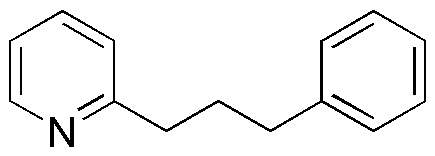2-(3-Phenylpropyl)pyridine is widely utilized in research focused on:
- Pharmaceutical Development: This compound serves as a key intermediate in the synthesis of various pharmaceuticals, particularly those targeting neurological disorders, enhancing drug efficacy and specificity.
- Agrochemical Formulations: It is used in developing agrochemicals, providing effective solutions for pest control while minimizing environmental impact, making it a preferred choice in sustainable agriculture.
- Material Science: The compound is incorporated into polymer formulations, improving the mechanical properties and thermal stability of materials, which is crucial for industries like automotive and construction.
- Flavor and Fragrance Industry: Its unique aromatic profile allows it to be used in creating complex fragrances and flavorings, appealing to manufacturers of perfumes and food products.
- Research Applications: In academic and industrial research, it is utilized as a building block for synthesizing novel compounds, facilitating advancements in chemical research and innovation.
Informations générales
Propriétés
Sécurité et réglementation
Applications
2-(3-Phenylpropyl)pyridine is widely utilized in research focused on:
- Pharmaceutical Development: This compound serves as a key intermediate in the synthesis of various pharmaceuticals, particularly those targeting neurological disorders, enhancing drug efficacy and specificity.
- Agrochemical Formulations: It is used in developing agrochemicals, providing effective solutions for pest control while minimizing environmental impact, making it a preferred choice in sustainable agriculture.
- Material Science: The compound is incorporated into polymer formulations, improving the mechanical properties and thermal stability of materials, which is crucial for industries like automotive and construction.
- Flavor and Fragrance Industry: Its unique aromatic profile allows it to be used in creating complex fragrances and flavorings, appealing to manufacturers of perfumes and food products.
- Research Applications: In academic and industrial research, it is utilized as a building block for synthesizing novel compounds, facilitating advancements in chemical research and innovation.
Documents
Fiches de données de sécurité (FDS)
La FDS fournit des informations de sécurité complètes sur la manipulation, le stockage et l’élimination du produit.
Spécifications du produit (PS)
Le PS fournit une description complète des propriétés du produit, notamment sa composition chimique, son état physique, sa pureté et les exigences de stockage. Il détaille également les plages de qualité acceptables et les applications prévues du produit.
Certificats d'analyse (COA)
Recherchez des certificats d'analyse (COA) en saisissant le numéro de lot du produit. Les numéros de lot et de lot se trouvent sur l'étiquette d'un produit, après les mots « Lot » ou « Lot de fabrication ».
Numéro de catalogue
Numéro de lot/série
Certificats d'origine (COO)
Ce certificat d'exploitation confirme le pays dans lequel le produit a été fabriqué, et détaille également les matériaux et composants utilisés et s'il est issu de sources naturelles, synthétiques ou autres sources spécifiques. Ce certificat peut être requis pour les douanes, le commerce et la conformité réglementaire.
Numéro de catalogue
Numéro de lot/série
Fiches de données de sécurité (FDS)
La FDS fournit des informations de sécurité complètes sur la manipulation, le stockage et l’élimination du produit.
DownloadSpécifications du produit (PS)
Le PS fournit une description complète des propriétés du produit, notamment sa composition chimique, son état physique, sa pureté et les exigences de stockage. Il détaille également les plages de qualité acceptables et les applications prévues du produit.
DownloadCertificats d'analyse (COA)
Recherchez des certificats d'analyse (COA) en saisissant le numéro de lot du produit. Les numéros de lot et de lot se trouvent sur l'étiquette d'un produit, après les mots « Lot » ou « Lot de fabrication ».
Numéro de catalogue
Numéro de lot/série
Certificats d'origine (COO)
Ce certificat d'exploitation confirme le pays dans lequel le produit a été fabriqué, et détaille également les matériaux et composants utilisés et s'il est issu de sources naturelles, synthétiques ou autres sources spécifiques. Ce certificat peut être requis pour les douanes, le commerce et la conformité réglementaire.

